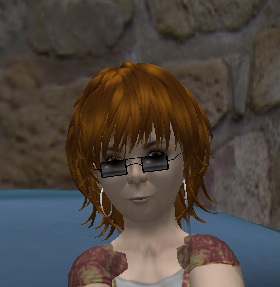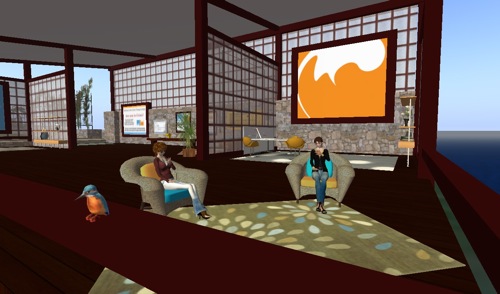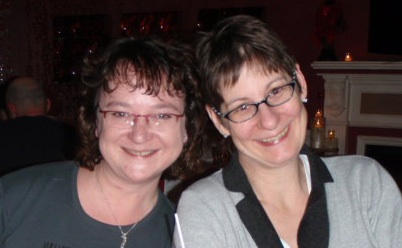DeeAnna Nagel and Kate Anthony are psychotherapists and founders of the Online Therapy Institute. The pair have only recently expanded their work to Second Life, but they have extensive experience in working with people therapeutically online. The pair now have a presence on Jokaydia in Second Life. I caught up with them to talk online counselling / therapy.
Lowell: Can you give a brief outline of your professional experience /qualifications pre-Second Life / online therapy?
 DeeAnna: I have a Master of Education in Rehabilitation Counseling and a Bachelor of Science in Mental Health and Human Services. I have worked in the mental health field for nearly 20 years. About 10 years ago I discovered the power of the Internet and began providing online chat and email through a couple of e-clinics. Over the years I have always maintained a part-time practice online and have integrated technology in work settings working with interns, employees and clinical supervisees. I have been training therapists since 2001 about the ethical issues pertaining to technology and mental health. Now 100% of my work life is devoted to either providing online therapy or teaching others about online therapy.
DeeAnna: I have a Master of Education in Rehabilitation Counseling and a Bachelor of Science in Mental Health and Human Services. I have worked in the mental health field for nearly 20 years. About 10 years ago I discovered the power of the Internet and began providing online chat and email through a couple of e-clinics. Over the years I have always maintained a part-time practice online and have integrated technology in work settings working with interns, employees and clinical supervisees. I have been training therapists since 2001 about the ethical issues pertaining to technology and mental health. Now 100% of my work life is devoted to either providing online therapy or teaching others about online therapy.
Kate Anthony: I have a Master of Science in Therapeutic Counselling and a Bachelor of Science in Psychology, and am halfway through a PhD on the topic of Technology and Mental Health. At around the same time as I discovered how powerful relationships over the Internet can be and based my MSc thesis on that. From that, I co-authored the British Association for Counselling and Psychotherapy (BACP) Guidelines for Online work (including Supervision) through its 3 editions. I have trained mental health professionals to work online since 2002, have published widely including textbooks, and was recently made a Fellow of BACP for my work and DA and I are both past-Presidents of the International Society for Mental Health Online (ISMHO).
Lowell Cremorne: What was the event that led to you realising the potential of virtual worlds for counselling interventions
DeeAnna Nagel: There was no single event for me; just a realisation that virtual world settings offer another level of sensory experience that could enhance the therapeutic process.
 Kate Anthony: I realised this in 2001 after speaking at a conference about Telephone Helplines. The Keynote speaker was head of BTExact Technologies, and he referred to the future of virtual worlds, and avatars specifically, being part of the future of health care. Most of the audience was laughing at the concept -– I wasn’t. I went on to work with him and his team to explore the concept and write a white paper on the topic (Anthony, K. and Lawson, M (2002). The Use of Innovative Avatar and Virtual Environment Technology for Counselling and Psychotherapy. Available online at www.kateanthony.co.uk/research).
Kate Anthony: I realised this in 2001 after speaking at a conference about Telephone Helplines. The Keynote speaker was head of BTExact Technologies, and he referred to the future of virtual worlds, and avatars specifically, being part of the future of health care. Most of the audience was laughing at the concept -– I wasn’t. I went on to work with him and his team to explore the concept and write a white paper on the topic (Anthony, K. and Lawson, M (2002). The Use of Innovative Avatar and Virtual Environment Technology for Counselling and Psychotherapy. Available online at www.kateanthony.co.uk/research).
Lowell Cremorne: Your Online Therapy Institute offers consultancy including advice on marketing counselling services online, but it seems you’ve carefully differentiated your SL consultancy to avatar familarisation etc. Would you agree that virtual worlds as an actual intervention mechanism are not evolved enough yet?
DeeAnna Nagel: The potential for therapeutic intervention in virtual world settings is already available – but not necessarily cost-effective for the private practitioner. Second Life is not encrypted and while we could offer therapy using secure methods such as a Sky Box, we have chosen not to. Proprietary software is being developed by companies and institutions for use in SL and other virtual worlds, and at some point private practitioners will be able to provide secure and encrypted services. Until that happens, we can, as you say, utilise our SL office as a way to meet people who want to provide an avatar representation and for other educational and consultancy opportunities.
Lowell Cremorne: What do you think needs to occur for people to be able to trust in-world therapy?
DeeAnna Nagel: Security including encryption is paramount. In addition, virtual world platforms need to be less cumbersome and be able to run on different platforms without the constant risk of technological breakdowns.
Lowell Cremorne: A common component of media coverage of virtual worlds is addiction – for the small percentage of people who may have a definable addiction, can the cause also play a role in the treatment? What I’m getting at here is whether in-world therapy for those addicted to virtual world interaction is a sensible treatment option or a damaging option.
DeeAnna Nagel: This should be taken on a case-by-case basis- I do offer online text-based therapy via chat and email to people who identify with Internet addiction. I think working with addicts inworld allows the client to experience a healthy relationship online and offers a way to model use of technology in appropriate ways. Technology is such a part of our social and vocational fabric now that people need to be able to integrate back to using technology but in healthy ways with appropriate boundaries. The work becomes about establishing and maintaining healthy relationships just as we have done with face-to-face clients for years.

Lowell Cremorne: Rapport-building is key for successful therapy – how best is that done online?
DeeAnna Nagel: Consideration should be given to the disinhibition effect. Online, people are less inhibited and likely to disclose information due to the person’s sense of anonymity. When working therapeutically, on the surface, this can be a plus in establishing rather quick rapport, but therapists also have a responsibility to prepare clients about disclosing personal information too quickly and then helping the client modulate the emotional intensity throughout the process.
Kate Anthony: The concept of “presence†is also important here – where is the client and where are you during the process? Most of my trainees agree post-training that the therapeutic work takes place somewhere between the two pieces of hardware (including mobile hardware) in Cyberspace. The mutual journey – and the rapport that goes with it – seems to take place in a nebulous arena, but actually the understanding by both client and counsellor as to how it exists for them facilitates the rapport.
Lowell Cremorne: How much real-world identification do you believe needs to occur prior to therapy commencing?
Kate Anthony: I think it essential for the client to be able to verify identity of the therapist, but this could be done via a third party – such as a professional organisation. Opinion varies widely from a client-identification point of view. Purists prefer to work with whatever the client is offering, subject to some legal identity checks in some places such as the client possibly being under age. The argument there is that the psyche that the client presents, via avatar or text, is a valid psyche to work with. Other practitioners prefer to make several checks as to how the client exists offline (we feel the phrase “real-world†is outdated, incidentally, so prefer to refer to online and offline). Personally, I feel that with a robust intake form and assessment procedure, further identification may simply get in the way of the therapeutic work which often depends on uniquely online societal norms (such as disinhibition and the perceived anonymity).

Lowell Cremorne: Is confirming real world gender / age / cultural identity important for good therapeutic outcomes online?
DeeAnna Nagel: Yes- as with face-to-face, the person’s identification is important to determine if the work between therapist and client is a good fit. Cultural differences should be taken on a case-by-case basis.
Kate Anthony: Yes, particularly with regard to age and informed consent.
Lowell Cremorne: What issues / mental health states would you feel uncomfortable dealing with online?
DeeAnna Nagel: For the most part, I am comfortable working with people online that have issues I am comfortable working with face-to-face. As long as I feel competent about the clinical issues and have the proper training, most mental health interventions can occur online. For me, it is difficult to work with someone who is obviously intoxicated or obviously decompensating and showing signs of delusional and irrational behavior- but this is whether the client is face-to-face or online. Certainly, when working via distance, the client’s geographical resources should be determined should crisis intervention become necessary.
Kate Anthony: And that exact point is how I train upcoming online mental health professionals– that with the Internet it is simple to explore a clients alternative crisis interventions based on their geographical location. Other concerns are working with people who are in a relationship that involves domestic violence. Safety issues for the victim come into play if he or she is using a computer that the perpetrator has access to and may be monitoring with a keystroke program.
Lowell Cremorne: Whether it be in a virtual world or via more traditional online methods, do you find you’re less likely to run into personal boundary issues, or is it just as much a challenge?
DeeAnna Nagel: For me, the boundaries are not blurred. I have always maintained boundaries in person and online but with the advent of social networking, I am consulting with more and more professionals who are struggling with this issue. What to do if a client friends their therapist on Facebook for instance and many times the dilemmas are ethical in nature- with regard to either confidentiality or dual relationships.
Lowell Cremorne: Are you aware of any formalised professional associations for online therapists to communicate and if not, how do you see the momentum developing so that this occurs?
Kate Anthony: There is the International Society for Mental Health Online (ISMHO) as mentioned, and more recently ACTO-UK (Association for Counsellors and Therapists Online – UK) – an organisation for UK based online therapists. The latter is holding it’s first conference (online and offline simultaneously) in April. Our fear is that many small organisations will crop up here and there with narrow ideas – what the Online Therapy Institute strives for is a global agreement as to how each of these associations can work together to disseminate knowledge and stimulate growth of the field to the greater good of online work, whether in virtual worlds or via other modalities.
DeeAnna Nagel: To that end we have developed the Ethical Framework for the use of Technology in Mental Health that offers Best Practice standards regardless of the practitioner’s geographic location.
Lowell Cremorne: What are your plans over the coming year for your Second Life work? Have you considered other worlds?
DeeAnna Nagel: We explore other worlds as they appear, and not always necessarily in an obvious way. For example, the Online Therapy Institute has a strong interest in the prevention and treatment of Cyberbullying, and a virtual world such as Club Penguin, for example, could be instrumental in that aim. Plans for the coming year is to explore those platforms that meet the Institute’s requirements for safe and secure client-therapist interaction, and continue to develop training for conducting therapy in virtual worlds.
Dr. Zur, your article is a great resource! Thank you for sharing. I have taken the opportunity to blog about it and I hope you will consider joining us at the Online Therapy Institute. http://onlinetherapyinstitute.ning.com/profiles…
DeeAnna Merz Nagel
Online Therapy Institute
The question of therapists befriending their clients on Internet social networks is very a complex question and was addressed in my “Google Factor” paper at http://www.zurinstitute.com/onlinedisclosure.html . I agree that therapists must be thoughtful and cautious. However they cannot always avoid interacting with clients in a non-clinical way.
Ofer Zur, Ph.D.
Director, Zur Institute
http://www.zurinstitute.com
There are pros and cons to purchasing land in SL or renting space. We have rented space on the Islands of Jokaydia http://jokaydia.com/ and they managed our build as well. This works well for us.
DeeAnna
I’m starting up a new company soon. Should I register a virtual office space or should I go ahead with renting a small space first? What are your thoughts?
ah
ah